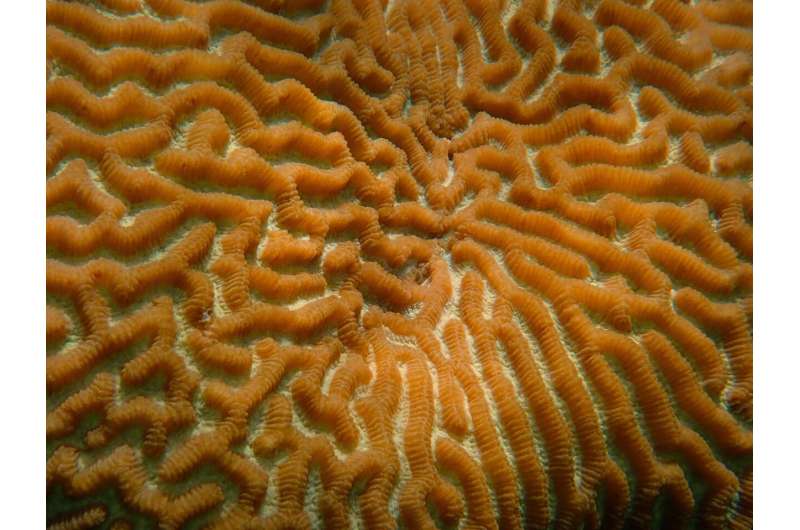The Florida Aquarium has reached another major milestone in its mission to restore the coral reefs, thanks to crossbreeding and cryopreservation.
Scientists have bred grooved brain corals collected near Fort Lauderdale and matured in the lab, with wild samples from more southern waters.
The result? A smattering of golden brown coral babies, living on small ceramic tiles at the aquarium’s Apollo Beach campus.
“Little miracles,” said Emily Williams, a biologist on the coral conservation team.
The successful reproduction effort created offspring with greater genetic diversity and disease resistance than those populating the Florida Atlantic coast, scientists say. That means they may be better equipped to withstand the threats ravaging the world’s third largest reef, including climate change and ocean acidification.
Stony tissue coral disease also entered Florida reefs in 2014, obliterating vast stretches of 20 coral species.
“The more genetic diversity the corals have, the better chance they eventually have to battle threats and changes,” senior biologist Rachel Serafin said.
The crossbred coral babies grow in a golden brown color on rectangular ceramic tiles.
In an ideal future, devastated ecosystems could be rebuilt with these stronger, lab-spawned samples. Red and orange corals that first felt water in a tank could repopulate the waters off Martin County south to the Florida Keys.
“Our end goal is to put ourselves out of a job,” Williams said. “To restore the corals to their former glory where they are happy and healthy and thriving without us.”
Researchers at the Florida Aquarium have been working toward that goal for years. They coaxed imperiled Atlantic Ocean coral into spawning in a laboratory in late 2019. Ridged cactus coral followed closely behind, in April 2020.
But this May marked the first time Florida preservationists used frozen, preserved sperm to breed samples collected miles apart, at different times.
The Florida Aquarium scavenged the Fort Lauderdale coast for healthy grooved brain corals to save from stony tissue coral disease in spring 2018 and 2019. As part of the Florida Coral Rescue Project, researchers rushed the animals out of vulnerable waters, and the rescued colonies spawned under human care.
Williams stored milliliters of resulting sperm in liquid nitrogen and a substance that freezes the tissues, indefinitely.
On the other side of the Sunshine State last month, UM scientists initiated a similar process: Collecting and cryopreserving sperm from wild brain corals off Key Largo.
Then the two institutions exchanged samples.
With two white metal containers of sperm in her car’s backseat, Williams left for Naples. “Like a soccer mom driving the kids,” Serafin said.
A UM researcher in South Florida drove toward her.
They exchanged specimens in a fast-food parking lot on May 7.
The defrosted sperm mingled with eggs, slowly but surely, at both facilities that evening. Researchers crafted ideal conditions for the samples by manipulating light and water levels.
Magic ensued.
Watching the coral reproduction process was like seeing “a living snow globe with little bundles, floating to the surface,” Williams said. “As those bundles break down, the water became cloudy and hazy with the sperm.”
Two days later, coral larvae from the mixtures began metamorphosing into baby corals in the Florida Aquarium lab. The same thing was happening in Miami. Both institutions had reared crossbred offspring.
It’s an impressive feat, almost impossible naturally, UM marine biology professor Andrew Baker said.
The two brain coral specimens used in the effort are otherwise unlikely to find one another, because of the distance between their oceanic homes. Only in the lab can the animals be brought together to reproduce.
“That’s a hopeful sign that even though there are all these horrible dangers for the corals, there are things that science can do,” Baker said.
Just one pair of brain corals can produce thousands of offspring each year. When bred in a controlled laboratory, survival can be as high as 50%, compared with less than 1% in the wild.
Now researchers turn to the lives ahead of the new crossbred baby corals.
The Florida Aquarium placed the babies on non-toxic tiles, in shallow tanks with circulating saltwater. The animals will be shadowed and sheltered to maturity, or until preservationists determine an alternate next step.
They hope the animals can one day be released into the Atlantic, to thrive and reproduce independently.
Reefs could be saved by these reproduction efforts, by strengthening the species. The recent findings in Florida have been shared with coral preservationists worldwide, who are eager to mend comparably vulnerable coral ecosystems in Australia, South America and beyond.
Losing corals is not an option for the oceans, Serafin said.
“Coral restoration is increasingly relying on sexual reproduction and selective breeding,” added Baker. “We can’t just wait for nature to correct the balance and repopulate the reefs. We have to act now. Extinction is forever.”
